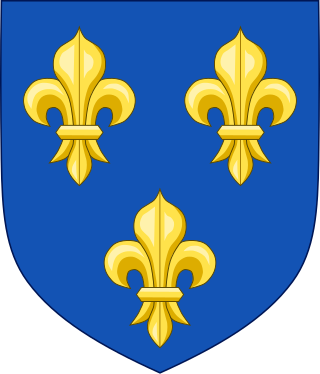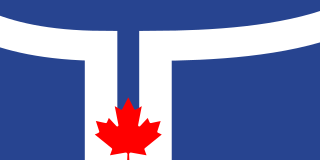
A national flag is a flag that represents and symbolizes a given nation. It is flown by the government of that nation, but can also be flown by its citizens. A national flag is typically designed with specific meanings for its colours and symbols, which may also be used separately from the flag as a symbol of the nation. The design of a national flag is sometimes altered after the occurrence of important historical events. The burning or destruction of a national flag is a greatly symbolic act.

The fleur-de-lis, also spelled fleur-de-lys, is a common heraldic charge in the shape of a lily. Most notably, the fleur-de-lis is depicted on the traditional coat of arms of France that was used from the High Middle Ages until the French Revolution in 1792, and then again in brief periods in the 19th century. This design still represents France and the House of Bourbon in the form of marshalling in the arms of Spain, Quebec and Canada, for example.

The flag of Serbia, also known as the Tricolour, is a tricolour consisting of three equal horizontal bands, red on the top, blue in the middle, and white on the bottom, with the lesser coat of arms left of center. The same tricolour, in altering variations, has been used since the 19th century as the flag of the state of Serbia and the Serb people. The current form of the flag was adopted in 2004 and slightly redesigned in 2010.

The coat of arms of the Republic of Croatia consists of one main shield and five smaller shields which form a crown over the main shield. The main coat of arms is a checkerboard (chequy) that consists of 13 red and 12 white fields. It is also informally known in Croatian as šahovnica. The five smaller shields represent five different historical regions within Croatia.

The flag of Bosnia and Herzegovina contains a medium blue field with a yellow right triangle separating said field, and there are seven full five-pointed white stars and two half stars top and bottom along the hypotenuse of the triangle.

The flag of Portugal is the national flag of the Portuguese Republic. It is a rectangular bicolour with a field divided into green on the hoist, and red on the fly. The lesser version of the national coat of arms of Portugal is centered over the colour boundary at equal distance from the upper and lower edges. Its presentation was done on 1 December 1910, after the downfall of the constitutional monarchy on 5 October 1910. However, it was only on 30 June 1911, that the official decree approving this flag as the official flag was published. This new national flag for the First Portuguese Republic, was selected by a special commission whose members included Columbano Bordalo Pinheiro, João Chagas and Abel Botelho. The conjugation of the new field color, especially the use of green, was not traditional in the Portuguese national flag's composition and represented a radical republican-inspired change that broke the bond with the former monarchical flag. Since a failed republican insurrection on 31 January 1891, red and green had been established as the colours of the Portuguese Republican Party and its associated movements, whose political prominence kept growing until it reached a culmination period following the Republican revolution of 5 October 1910. In the ensuing decades, these colours were popularly propagandised as representing the hope of the nation (green) and the blood of those who died defending it (red), as a means to endow them with a more patriotic and dignified, therefore less political, sentiment.

The flag of the Dominican Republic represents the Dominican Republic and, together with the coat of arms and the national anthem, has the status of a national symbol. The blue on the flag stands for liberty, the white for salvation, and the red for the blood of heroes. The civil flag follows the same design, but without the charge in the center. The flag was designed by Juan Pablo Duarte.

The coat of arms of the Republic of Serbia consists of two main heraldic symbols which represent the identity of the Serbian state and Serbian people across the centuries: the Serbian eagle and the Serbian cross.

There are two flags in official use in the Serbian Autonomous Province of Vojvodina, the Flag of Vojvodina and the Traditional flag of Vojvodina. Two flags are given the equal status in the Provincial Assembly Decision on the Appearance and Usage of Symbols and Traditional Symbols of AP Vojvodina adopted in 2016.

A red star, five-pointed and filled, is a symbol that has often historically been associated with communist ideology, particularly in combination with the hammer and sickle, but is also used as a purely socialist symbol in the 21st century. It has been widely used in flags, state emblems, monuments, ornaments, and logos.

The City of Toronto flag, often simply referred to as the flag of Toronto, is the flag adopted by Toronto City Council to represent the city. The flag was designed by Renato De Santis and includes a white outline of Toronto City Hall on a blue field, and a red maple leaf at the base of the towers.

The city of Kraków uses a coat of arms, a seal, official colors, a flag, and a banner as its official symbols. Additionally, a number of semi-official and unofficial symbols of the city are also used.

The Serbian Cross, also known as the Firesteels, is one of national symbols of Serbia, part of the coat of arms and flag of Serbia. It is based on the tetragrammic cross emblem/flag of the Byzantine Palaiologos dynasty, with the difference that in Serbian use the cross is usually white on a red background, rather than gold on a red background.

The Football Association of Serbia is the governing body of football in Serbia, based in Belgrade. It organizes Serbian football leagues, namely the Serbian Superliga, the Serbia national football team, as well as the Second Leagues.

The coat of arms of Belgrade is the official symbol of the City of Belgrade and is stable in three levels - as Basic or Small, Medium and Large.

The city flag of Los Angeles consists of a background of three notched stripes of green, gold and red. The flag was designed by Roy E. Silent and E.S. Jones in 1931 for the Los Angeles sesquicentennial from 1781.

The coat of arms of the German state and city of Hamburg is a kind of national emblem. The coat of arms and the flags are regulated by the constitution of Hamburg and law. The colors of Hamburg are white and red. One of the oldest versions of the castle is found on a seal in 1241.

The flag of the Balearic Islands is the official flag of the Balearic Islands, an archipelago and autonomous community of Spain located in the western Mediterranean Sea. The flag, which was adopted in the 1983 Statute of Autonomy, incorporates the design of the Senyera.

The Serbian eagle is a double-headed heraldic eagle, also known as the White eagle, a common symbol in the history of Serbian heraldry and vexillology. The double-headed eagle and the Serbian cross are the main heraldic symbols which represent the national identity of the Serbian people across the centuries, originating from the medieval Nemanjić dynasty. The eagle, defaced with the cross, has been used in the coat of arms of the Kingdom of Serbia from 1882 to 1918 and in contemporary coat of arms of the Republic of Serbia since 2004.

The use of heraldry in Serbia or by Serbs is used by government bodies, subdivisions of the national government, organizations, corporations and by families. Serbian heraldry belongs culturally to the Byzantine tradition.




















